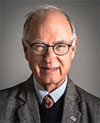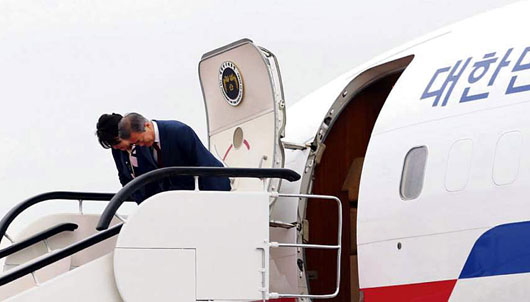Special to WorldTribune.com
 By Donald Kirk
By Donald Kirk
WASHINGTON — U.S. President Donald Trump faces a serious problem when he meets South Korea’s President Moon Jae-In Monday in New York.
How can he go on promising concessions to North Korea when the State Department has already rejected North Korea’s demand for “corresponding measures” by the U.S. before agreeing to shut down the North’s nuclear complex at Yongbyon 100 kilometers north of Pyongyang.
Despite all the upbeat publicity surrounding Moon’s visit to North Korea, State Department spokeswoman Heather Nauert said emphatically that U.S. policy had not changed and that North Korea must first give up its nuclear program before the U.S. acts on more of the North’s demands. Along with Moon, who will be attending the annual meeting of the General Assembly of the UN, leading members of his Minjoo or Democratic Party are coming to the U.S. to convince political figures, media stars, academic experts and others of the “success” of the summit.

South Korea’s foreign minister, Kang Kyung-Wha, is to meet in New York with Secretary of State Mike Pompeo in hopes of persuading the State Department to alter what Moon’s government sees as a hard-line position.
Even if these meetings get nowhere, however, Moon is hoping that Trump will agree to another summit with Kim, who is confident he can talk Trump into agreeing on a formal end-of-war “peace declaration” and relief from sanctions imposed by the UN and U.S. after the North’s nuclear and long-range missile tests, last conducted a year ago.
It’s not clear how Trump will respond under such pressure. Certainly he would like nothing better, going into critical mid-term congressional elections in November, to be able to go on claiming that he personally has “resolved” the North Korean issue, just as he said he had done after his summit with Kim in Singapore in June. In that spirit Trump’s responses have been nothing but positive with no hint of doubt that the Moon-Kim summit was a great success.
The fact is, however, that Kim Jong-Un granted no real concessions while entertaining Moon in their meetings, at the mass games in May First Stadium featuring thousands of performers and, finally, with a visit to sacred Mount Paektu.
Typical of the deception of Kim’s game with Moon was his claim to have shut down the Pungye-ri test site, destroyed in the sixth and last North Korean nuclear test in September, and then his promise to close, under international inspection, the site at Sohae used for testing the engines in missiles.
In fact, the North had already announced it was closing Sohae and is believed to have alternate sites elsewhere.
Moon promised, after returning to Seoul, to brief Trump in detail on all that Kim said, including what he claimed were specific plans for “denuclearization” as Trump and Kim agreed on in the vague joint statement they signed in Singapore.
In Washington, however, no one seriously believes Moon’s statement that Kim expressed his “wish to complete denuclearization at an early date” while focusing on “economic development.”
It seems inconceivable to analysts here that Kim would get rid of the nukes and missiles made at Yongbyon from plutonium processed by a five-megawatt reactor and from highly enriched uranium at secret sites elsewhere.
Bruce Bechtol, author of numerous books and articles on North Korea’s military activities, points out that North Korea refuses to provide a detailed list of its nuclear sites, including many hidden in caves and tunnel complexes that are not seen by satellite imagery.
Nor has North Korea said a thing about pulling back hundreds of thousands of troops within striking distance of Seoul and Incheon or withdrawing several thousand artillery pieces that could inundate South Korea’s northern region.
Bechtol and other analysts believe that Moon and his closest advisers have basically fallen for hollow assurances intended to undermine the U.S.-Korean alliance.
They are alarmed by Moon’s emphasis on a “peace declaration” as Kim has long advocated. The purpose, they say, would be simply to lay the groundwork for a peace treaty that would call for disbanding the United Nations Command under which U.S. and South Korean troops waged the Korean War.
Secondary agreements reached between Moon and Kim and their ministers are also cause for alarm. Both sides promised to close some of their guard posts along the Demilitarized Zone, but there is no way to check on what the North Koreans are doing.
Defense analysts here also point out that the agreement not to fly planes or drones within 10 kilometers of the DMZ severely restricts the ability of the Americans and South Koreans to see what the North Koreans are doing.
Yet another issue that does not seem to have come up during Moon’s visit was that of the North shipping coal and other products to the South and elsewhere via dummy companies set up in Vladivostok to make it appear as though the shipments were from Russia.
A number of ships bearing strange foreign flags have been carrying coal to South Korean ports in violation of sanctions that North Korea insists must be dropped – another condition set by the North before giving up its nuclear and missile program.
Increasingly, the Chinese and Russians are supporting North Korea despite sanctions. The U.S. has imposed still more sanctions against Russian companies and against the Chinese military in retaliation for China agreeing to buy Russian planes.
Although that deal does not directly involve North Korea, military analysts believe China may be planning to build up North Korea’s decrepit air force, consisting mainly of Soviet-built planes that are outdated and in need of repairs.
U.S. officials accuse both China and Russia of violating sanctions against North Korea while South Korea has failed to act effectively against illicit imports. These sensitive issues, however, do not appear to have come up for discussion between Moon and Kim.
Subscribe to Geostrategy-Direct __________ Support Free Press Foundation
